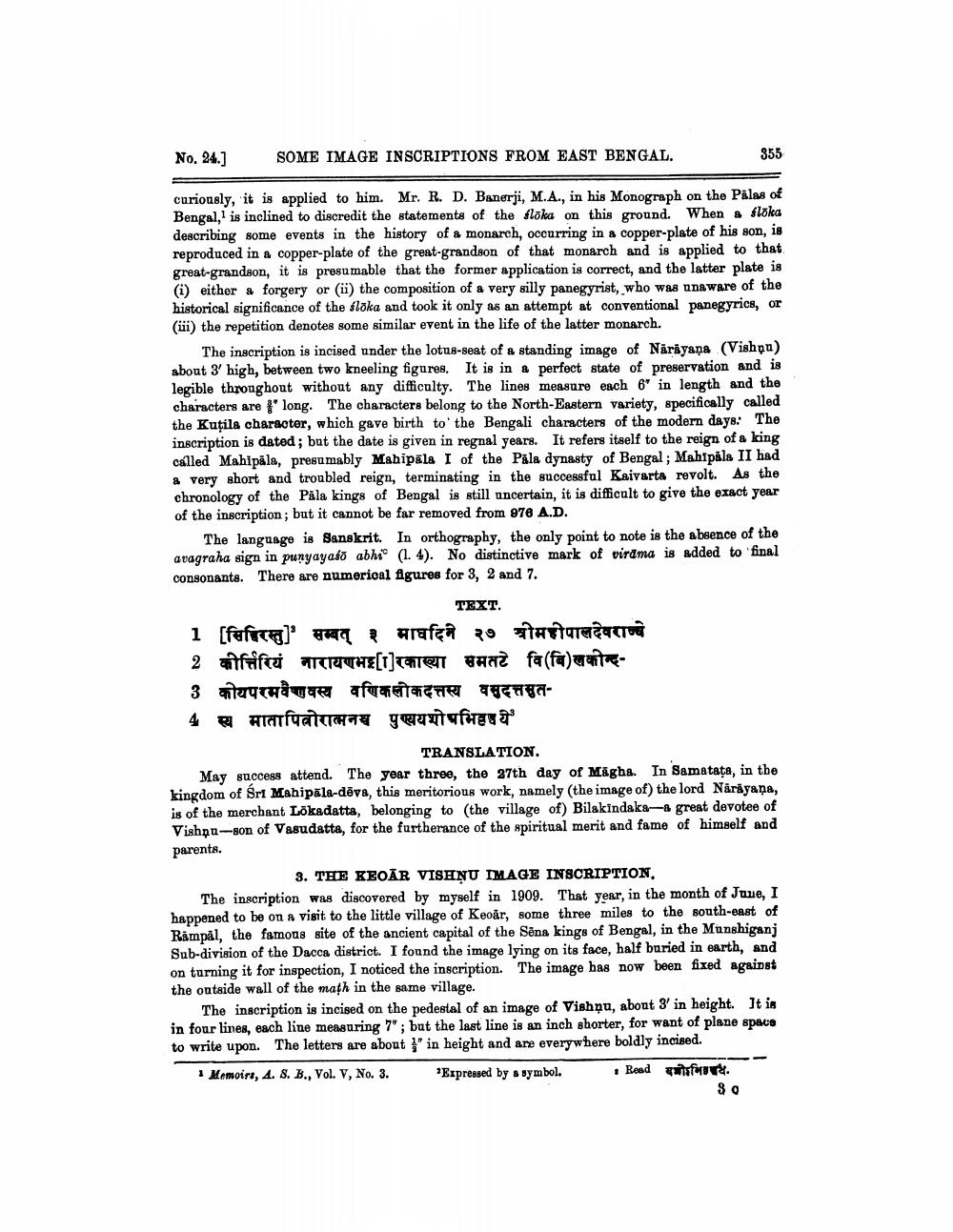________________
No. 24.7
SOME IMAGE INSCRIPTIONS FROM EAST BENGAL.
355
curiously, it is applied to him. Mr. R. D. Banerji, M.A., in his Monograph on the Pålas of Bengal, is inclined to discredit the statements of the floka on this ground. When & flöka describing some events in the history of a monarch, occurring in a copper-plate of his son, is reproduced in a copper-plate of the great-grandson of that monarch and is applied to that great-grandson, it is presumable that the former application is correct, and the latter plate is (i) either a forgery or (ü) the composition of a very silly panegyrist, who was unaware of the historical significance of the sloka and took it only as an attempt at conventional panegyrics, or (ii) the repetition denotes some similar event in the life of the latter monarch.
The inscription is incised under the lotus-seat of a standing image of Näräyana (Vishna) about 3' high, between two kneeling figures. It is in a perfect state of preservation and is legible throughout without any difficulty. The lines measure each 6" in length and the characters are " long. The characters belong to the North-Eastern variety, specifically called the Kuţila character, which gave birth to the Bengali characters of the modern days. The inscription is dated; but the date is given in regnal years. It refers itself to the reign of a king called Mahipala, presumably Mahipala I of the Pala dynasty of Bengal; Mahipala II had a very short and troubled reign, terminating in the successful Kaivarta revolt. As the chronology of the Pala kings of Bengal is still uncertain, it is difficult to give the exact year of the inscription; but it cannot be far removed from 978 A.D.
The language is Sanskrit. In orthography, the only point to note is the absence of the avagraha sign in punyayaso abh: (1.4). No distinctive mark of virdma is added to final consonants. There are numerical figures for 3, 2 and 7.
TEXT. 1 [सिथिरस्तु]' सम्बत् ३ माघदिने २७ श्रीमहीपालदेवराज्छ 2 fifru TTR THE[I]Tae ATT fa(fa)wate3 कोयपरमवैष्णवस्य वणिकलोकदत्तस्य वसुदत्तमुत4 स्य मातापित्रोरात्मनच पुण्ययशोपभिहये
TRANSLATION. May success attend. The year three, the 27th day of Māgha. In Samatata, in the kingdom of Sri Mahipala-dēva, this meritorious work, namely (the image of) the lord Narayana, is of the merchant Lökadatta, belonging to the village of) Bilakindaka- great devotee of Vishnu--son of Vasudatta, for the furtherance of the spiritual merit and fame of himself and parents.
3. THE KEOĀR VISHNU IMAGE INSCRIPTION The inscription was discovered by myself in 1909. That year, in the month of June, I happened to be on a visit to the little village of Keoår, some three miles to the south-east of Rampal, the famous site of the ancient capital of the Sēna kings of Bengal, in the Munshiganj Sub-division of the Dacca district. I found the image lying on its face, half buried in earth, and on turning it for inspection, I noticed the inscription. The image has now been fixed against the outside wall of the math in the same village.
The inscription is incised on the pedestal of an image of Vishnu, about 3' in height. It is in four lines, each line measuring 7"; but the last line is an inch shorter, for want of plane space to write upon. The letters are about ' in height and are everywhere boldly incised. Memoirs, 4. 8. B., Vol. V, No. 3. Expressed by a symbol. Read tusfoort
30




